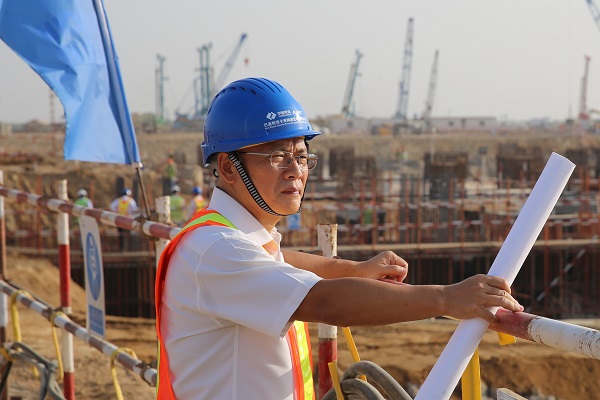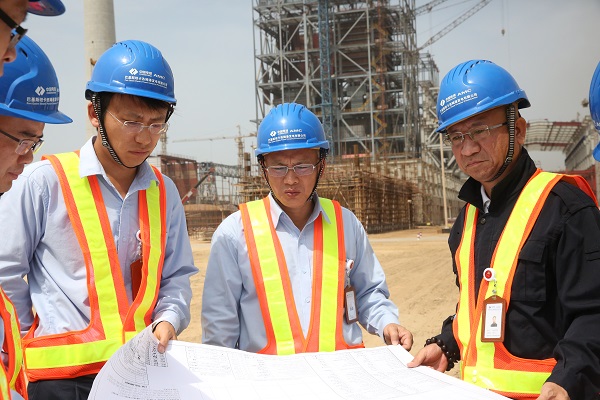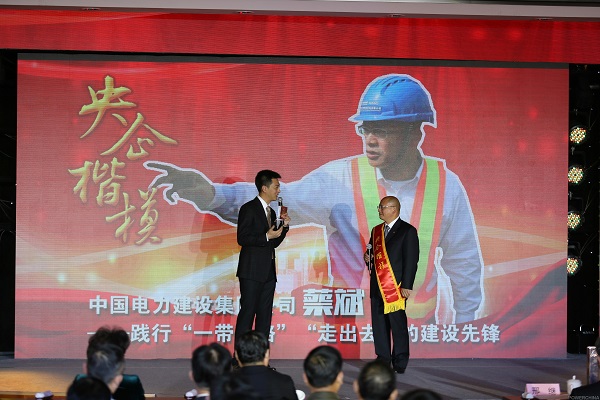The second unit of Port Qasim coal-fired power plant, the first large energy project carried out under the China-Pakistan Economic Corridor (CPEC), finished its 168-hour full load trial operation and started to generate electricity on Jan 24, 2018.
On that occasion, Cai Bin, general manager of the Port Qasim Electric Power Company of PowerChina Limited, felt a sense of relief -- a great weight that had been put on him for three years was finally set to be removed.

Cai Bin at a construction site of PowerChina’s overseas project [Photo/sasac.gov.cn]
This was not the first overseas project that Cai Bin chaired. He joined PowerChina as soon as he graduated from university in 1985. Ever since, Cai has taken part in or chaired 11 construction projects of power stations with an accumulated installed capacity of more than 10 million kilowatts, greatly promoting China’s technologies, equipment and culture abroad.
Nepal was his first stop. Later, Cai Bin was involved in the management of more than 10 projects, including the Tishreen Hydropower Station built on the Euphrates River in Syria, the Bakun Hydropower Station in Malaysia and Laos’ Nam Ou River Cascade Hydropower Plant.

Cai Bin (C) discusses with his colleague at a construction site of PowerChina’s overseas project.[Photo/sasac.gov.cn]
In March 2010, Cai Bin was placed in PowerChina’s first hydropower BOT project - the Nam Ngum 5 hydropower station in Laos, at a time when the project faced a terrible delay of completion due to challenging geological conditions.
He stepped into the ankle-deep mud in the tunnel to find out the leakage defects, and then worked out a plan to improve the efficiency in both construction and management.
Thanks to the plan, the hydropower station began to generate electricity one month ahead of schedule.
Cai has never flinched from challenges and difficulties
In August 2013, a catastrophic flood hit the Nam Ou River basin, with the maximum peak discharge amounting to 6,246 cubic meters per second.
Cai directed the workers at all the cascade hydropower stations to combat the flood on the site round the clock, paying no attention to his personal safety.
Cai Bin puts his heart and soul in every single project. Moreover, he is also good at multitasking by taking up challenges of two projects at once.
In 2012, he was once busy with the financing, population resettlement and environmental protection involved in the three cascade hydropower stations of the Nam Ou River Project while being in charge of the construction of the Nam Ngum 5 hydropower station.
He had to shuttle back and forth between two projects to handle all kinds of tasks, such as communicating with local governments and inspecting construction sites. An inspection tour to the three cascade stations of the first phase of Nam Ou River project usually involves him in a round trip of more than 900 km, passing through six counties in two provinces in Laos.
He himself couldn’t pinpoint out how many projects he had visited in the past 30 plus years.
Cai Bin is meticulous in quality no matter how tight the schedule is
When he chaired the Bakun Hydropower Station in Malaysia, he found that the building stones that were used to fill the dam was mixed with soil and urged the workers to dig it out and refill the dam with rock.
Although mixed fillers had a slight influence on the project and the refilling would certainly delay progress, Cai Bin still insisted on his request mercilessly.

Cai (R) is honored as a “model worker of centrally administered State-owned enterprises” at an awarding ceremony held by the State-owned Assets Supervision and Administration Commission of the State Council. [Photo/sasac.gov.cn]
In the past 30 years, he has spent most of his time in overseas projects. Due to immense pressure and irregular work and rest, Cai Bin suffers from high blood pressure and anti-hypertensive drugs has become one of his necessities.
In addition to project construction, Cai also attaches great importance to team building and the cultivation of young workers. He likes communicating with young people and often offers suggestions to them.
(Executive editor: Hao Wen)